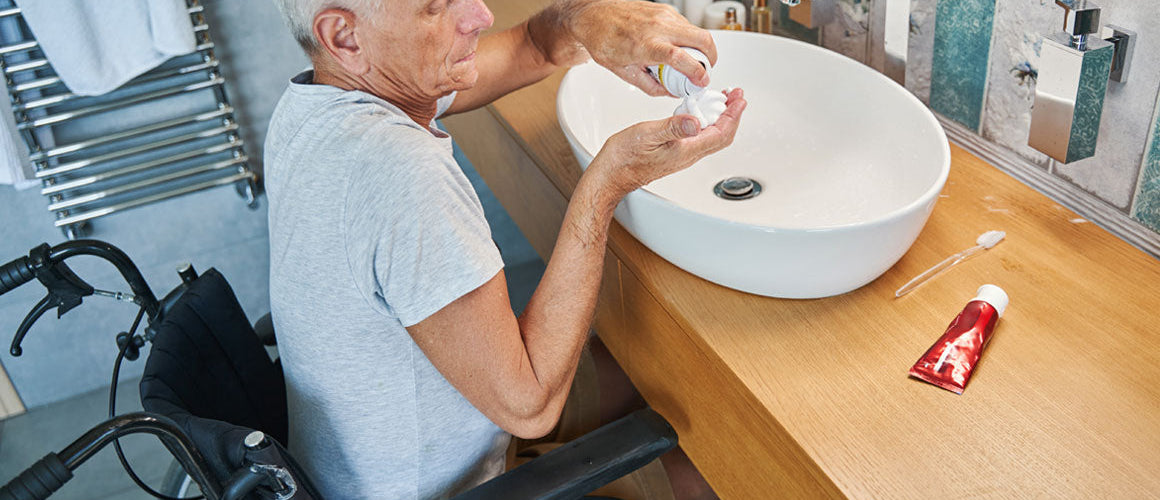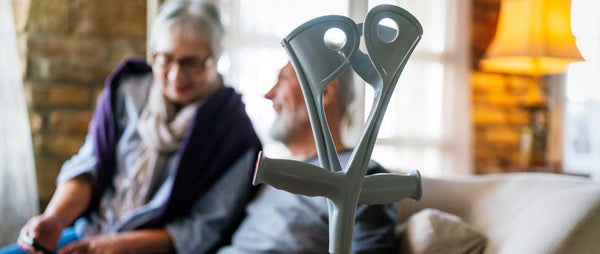Did you know that around a third of people over the age of 65 have at least one fall a year, and that this rises to one in two people over 80?
One of the most common places for falls to occur in the home is the bathroom and many of these falls result in injuries, which can significantly affect mobility or have even more serious health consequences.
In this article, we look at some bathroom design ideas for seniors that can help to minimise the risks of a fall, along with other tips for safer independent living.
Assessing the current bathroom design
Your elderly relative may have lived in their home for some time and they probably know it very well. However, there are still some potential hazards and risks in most properties that can become more problematic as your loved one gets older. It’s a good idea to assess how things are currently setup in the bathroom and see if any changes are needed to continue to support them to live independently. This can help you to ensure you’re doing everything possible to keep your elderly loved one safe at home.
As well as looking at ways to prevent falls generally, things to assess in the bathroom include:
The width of the bathroom entrance
This is especially important if your relative uses any walking aids, such as a walker, wheelchair or walking stick.
If the doorway width makes it difficult or awkward for them to get in and out of the bathroom, this could potentially cause a fall or injury. It might be that a change of door is needed to widen the entrance.
The flooring
Is the bathroom all on one level or are there any steps that could be a potential hazard?
Also look at the type of flooring and whether it’s suitable for a bathroom. Does it get particularly slippery when wet, or are there any rugs or mats on the floor that they could potentially slip or trip on too?

Are there any obstacles or clutter?
Small spaces like bathrooms can easily get cluttered and this can mean obstacles that could cause a trip or fall.
This can be anything from a pile of laundry waiting to be dealt with or towels not being stored out of the way to a stock of spare toilet rolls or cleaning products and toiletries being left out where they could fall off a shelf or be tripped over.
Is the lighting adequate?
Poor lighting can cause trips and falls, especially if your elderly relative’s vision is also not as good as it once was.
Some older properties don’t necessarily have adequate lighting either in or outside the bathroom, or the switches might be difficult to reach. This can potentially result in an accident if your loved one were to visit the bathroom in the middle of the night, for example.
Another thing to consider is if there is just one light bulb, for example, is this something that your elderly relative could easily change themselves if it were to blow, or could this cause potential problems too if they’re likely to attempt this without help?
Having more than one light in the bathroom and hallway will mean they are not literally left in the dark if a bulb needs replacing.

Is the toilet too low?
In the UK, most toilets fitted in bathrooms will be to a standard height, but this isn’t always suitable for someone who is perhaps more challenged by balance as they get older. Moving on and off the loo can be riskier if the distance down to it is further than it possibly needs to be – in this case, it could be worth considering a grab rails, or even a “high rise” loo.
Although just a few inches taller, they can relieve the pressure on your loved-one’s knees and joints, and often offers a much more comfortable seating position.
What’s the shower and bath situation?
Understanding how your elderly relative uses the bath and/or shower is important to assess the slip or fall risk in this area, which is probably higher than in any other part of the bathroom.
Stepping in and out of a bath, as well as getting down into it and up afterwards, can become increasingly challenging for many older people, as they need to deal with their balance as well as potentially a slippery wet floor and a bath tub too.
Check to see if your relative is able to use the existing bath taps easily. Looking and reaching up to fiddle with a shower can also potentially cause dizziness or other balance problems, so it might be that modifications are needed here too.
Look at the storage available and how it works
If every item in the bathroom has its own place to be safely stored out of the way, then this can make a big difference to the risk of tripping over clutter or an obstacle, but the wrong kinds of storage can also be a hazard in themselves too.
Here are a couple of considerations:
- Shelves or cupboards that are up high could be a problem to reach, as well as the potential danger of falling items.
- Stiff cupboard doors can also be a hazard, as not only are they difficult to open and close easily, the amount of force needed to get into the storage could cause an accident or injury too.
Once you have assessed their current bathroom, it might give you some ideas about the practical changes that you can make to ensure things are easier for them to manage and to help lower the risks of a fall or another kind of accident happening in this room. You might also decide to consider other independent living aids for around the home in general.

Ideas for the best bathroom design for seniors
The way that your loved one’s bathroom should ideally look and function will very much depend on them. Unfortunately, there isn’t a one-size-fits-all solution that suits everyone.
However, we’ve compiled some of the most popular changes that people can make so their elderly relatives can move around and use their bathroom space more easily and safely - to help remove some of the most common causes of falls.
Flooring suited to older people’s bathrooms
If the bathroom floor isn’t all on one level or there are changes in the surface that could cause a trip or slip, this can be a real issue, so dealing with this is a must. If you’re installing a new bathroom, now is the best time to consider non-slip tiles too.
All bath mats should have a non-slip backing and no other throws or rugs should ideally be used at all in this space.
Bath and walk-in shower ideas for elderly people
There are different potential solutions for bathing that can make a big difference to older people and maintaining their independence.
If a conventional bath is no longer working for them, but they want to continue to bathe rather than exclusively shower, there are walk-in baths that can be fitted which have a ‘door’ that is level with the floor and so doesn’t require a step up to get into. The ‘door’ is then sealed before the bath is filled with water. These baths also usually come with a raised seat to make getting up and down much easier too. Bath lifts are also available if needed.
A walk-in shower could be a good option if your relative is happy to shower instead of, or as well as, having a bath.
While care still needs to be taken by using non-slip surfaces such as shower mats and bathmats, walk-in showers don’t require any steps up or down and can have the shower controls positioned wherever is best for your loved one when fitted, such as lower down than conventionally, to make them easier to reach.
Shower seats or benches are also available so your relative can have a seated shower if that suits them better.

Consider lever taps if the current screw taps are getting more challenging to manage
Some older people can struggle with traditional taps as they get older, especially if they have arthritis or any condition that causes unsteadiness or lack of mobility in their hands.
Lever taps can be a great option as they are simply pushed up and down, or to the side, to switch on or off – which can be much easier to deal with on baths or basins.

Grab rails installed in key places
Consider whether a grab bar next to the toilet will help with going from sitting to standing more securely, and vice versa. A grab rail to help with getting in or out of the bath and/or shower can also be very useful.
Having grab rails in key places in a bathroom can make a huge difference to the risk of a fall or accident.
Consider a raised toilet seat if needed
Raised seats, especially when they also have arms, can be really useful for older people who might find keeping their balance a challenge when moving from standing to sitting and the reverse.
Add in accessible storage if needed
Having somewhere to hang a wet towel so that it doesn’t end up as a trip hazard on the floor is one consideration, along with making sure that all cupboards and shelves are easily accessed and at the right height for your older relative. This helps stop clutter from forming which means the risk of a fall is lower.
Add more lights
Adding a motion sensor light to the bathroom means that your loved one doesn’t need to find and use an awkward switch in the middle of the night - it also means that there’s an alternative to the main light if the bulb were to go and an immediate replacement isn’t possible.
Consider a waterproof personal alarm for peace of mind in the bathroom
One issue that many older people have is that if they were to fall in the bathroom and live alone, they might not be able to raise help. They might not have a mobile phone on them and even if they do, if they are using the bath or shower, it’s unlikely they could reach the phone to call for help if they were to slip or fall and suffer an injury.
Many of the wearable elderly alarms from TakingCare are waterproof and can be worn in the shower or bath, so if an accident were to happen, your elderly loved one would still be able to reach help by simply pushing the alert button.
Some elderly fall alarms also come with fall detection technology, which raise an alert automatically when a fall is detected - even if the individual is injured and unable to speak or otherwise call for help.
If your loved one does not want to wear an alarm pendant, or if you would like additional reassurance they are OK when you cannot be with them, there are smart home monitoring systems that send an alert when a change in behaviour indicates there may something wrong. Motion sensors can detect when a person has gone into a room and not returned, potentially because they have fallen or are unwell, and home sensors for the elderly can learn normal patterns of behaviour.
Browse personal alarms
You can choose from our full range of personal alarms to find the right one for your loved one and to provide peace of mind for you both that help is at hand if needed.



